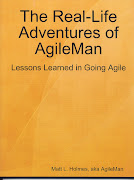 Just finished Chapter VI, another favourite of mine. In this one, we learn how Walter Kovacs became Rorschach, and it's not a pretty picture at all.
Just finished Chapter VI, another favourite of mine. In this one, we learn how Walter Kovacs became Rorschach, and it's not a pretty picture at all. The use of actual Rorschach ink blot tests within the story itself (and on the cover!) may seem at first like a clumsy attempt at irony, but as you pay greater and greater attention to the details of Alan Moore's script and how artist Dave Gibbons incorporates each of the blots' black shapes into the panels around each appearance, you begin to appreciate just how incredibly well-constructed this chapter really is.
One of the best lines from the series shows up in this issue. As he's about to get stabbed in the back while standing in the food line in prison, Rorschach grabs a hot, steaming platter of cooking fat and throws it in the attacker's face. While being dragged away to solitary confinement, Rorschach says, "None of you understand. I'm not locked up in here with you. You're locked up in here with me."
Later, after he finishes recounting the case that actually transformed him from Kovacs into Rorschach, he describes the revelation that completed the metamorphosis: "This rudderless world is not shaped by vague metaphysical forces. It is not God who kills the children. Not Fate that butchers them or Destiny that feeds them to the dogs. It's us. Only us."
His conversations in this issue are with the seemingly-unimportant supporting character, Dr Malcolm Long. The psychologist, recognizing in Kovacs a goldmine in terms of putting his own name on the map, gets considerably more than he bargained for in these interviews. And we learn that he's not just there to give Rorschach someone to talk to. Moore wisely introduces Long as a surrogate for the reader, in order to allow us to start out with him at Square One (thinking that Rorschach's a fascinating character who's maybe just a little "out there") and then discover incrementally, along with the doctor, just how little we actually knew about the man behind the moving mask. Everything that Rorschach's done up to that point in Watchmen is cast in a different light as we proceed through "The Abyss Gazes Also."
An interesting bit of detail that I'd probably picked up on previously but had forgotten involves the way in which Rorschach's dialogue is presented. The letterer uses a specific type of font for the character's words whenever he's in costume, except that his very early appearances (chronologically-speaking) didn't have that special effect in play. What might have seemed like a creative screw-up earlier (when a younger Rorschach was shown in flashbacks, without the speech effect) is now explained: his voice, body language and demeanour all changed as a result of that one case in 1975.
Going back one chapter, I marveled once again at the layout of the fifth issue, entitled "Fearful Symmetry." The entire 28 pages of it are composed in a symmetrical fashion, for the double-paged centre spread outward. Each corresponding pair of pages, moving out from the middle, showcase the same characters in the same settings. It's the sort of thing that you could miss even after a dozen readings, but once you notice it (or hear about it), you can't help but appreciate how effective it is at (subtly) conveying a cyclical feel to the events. Each path that you traveled down in getting to the midpoint is then traversed again, in reverse order, on the way back out. Just mind-numbingly impressive how much is packed into this 12-issue series!















No comments:
Post a Comment